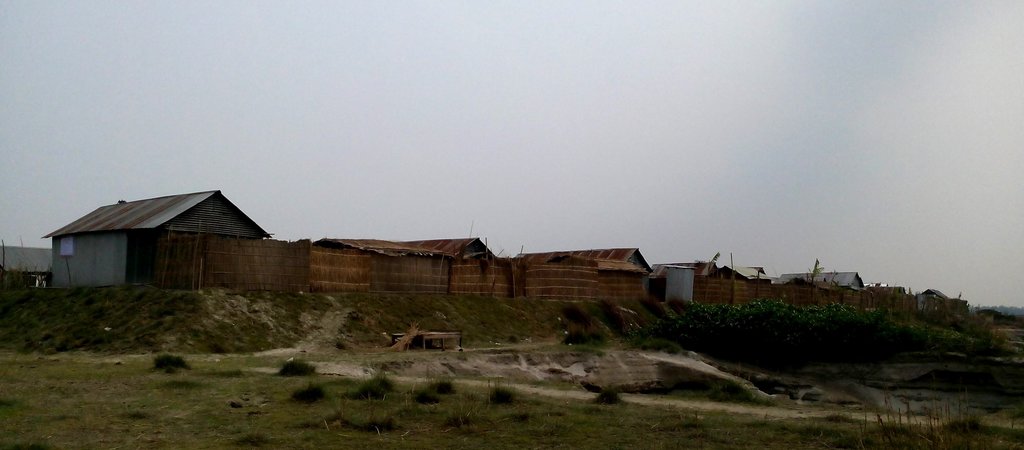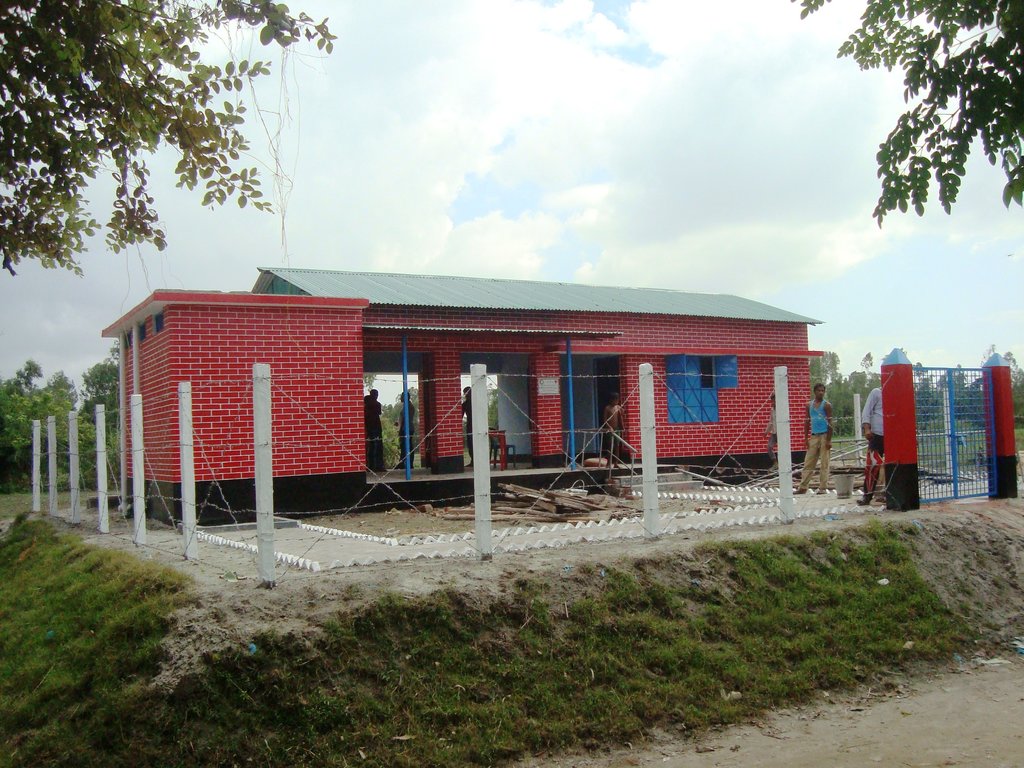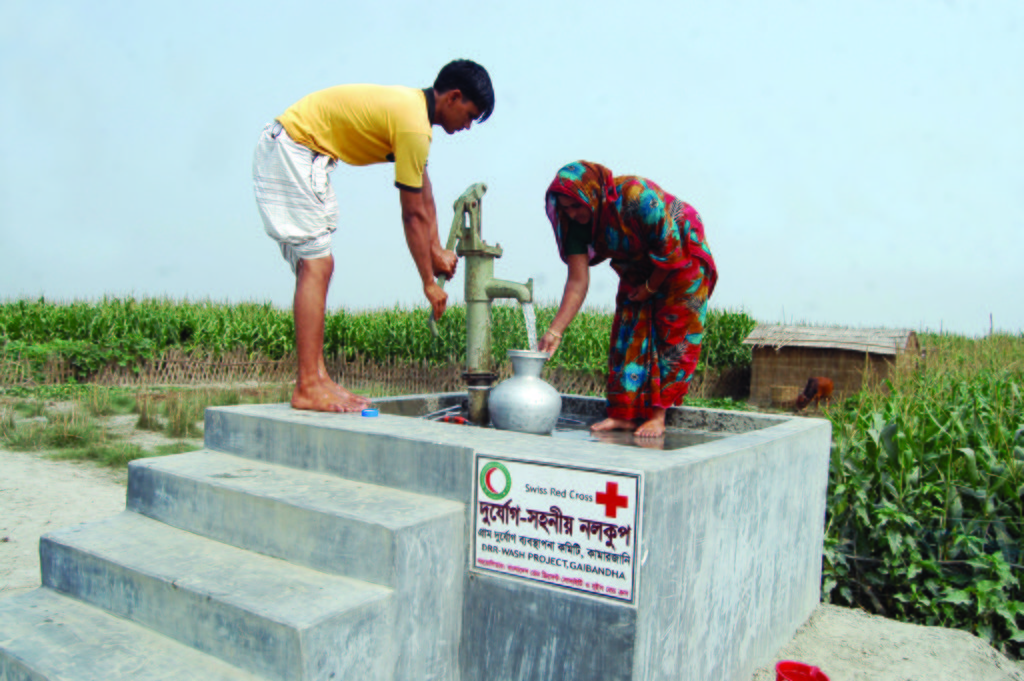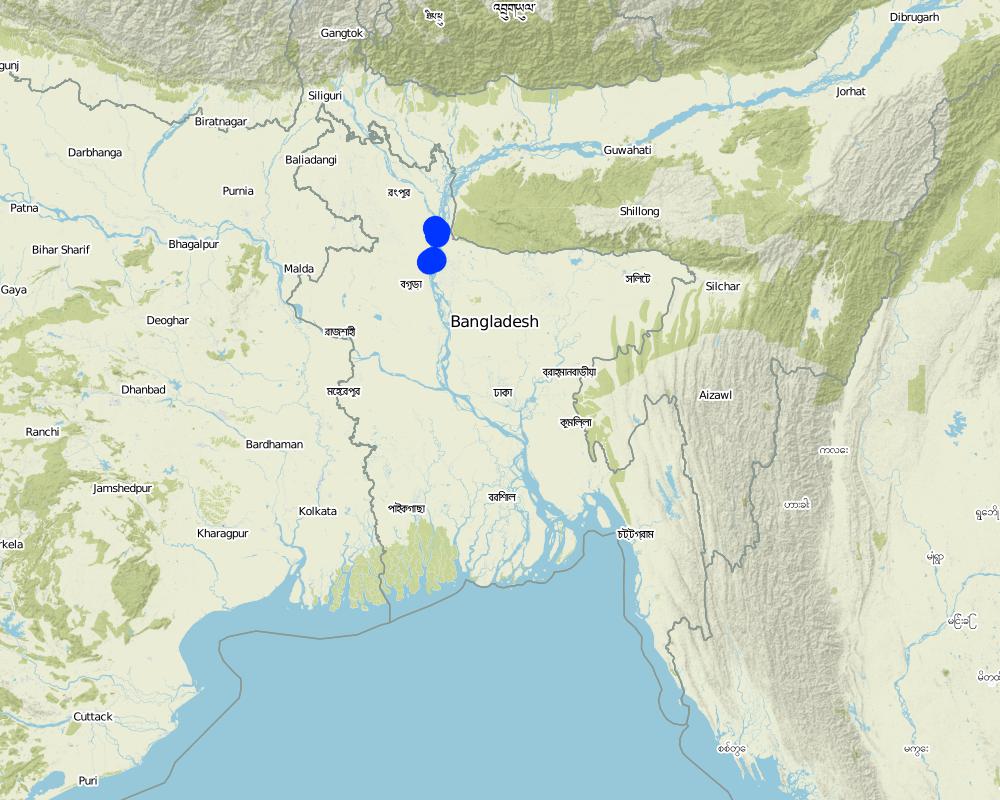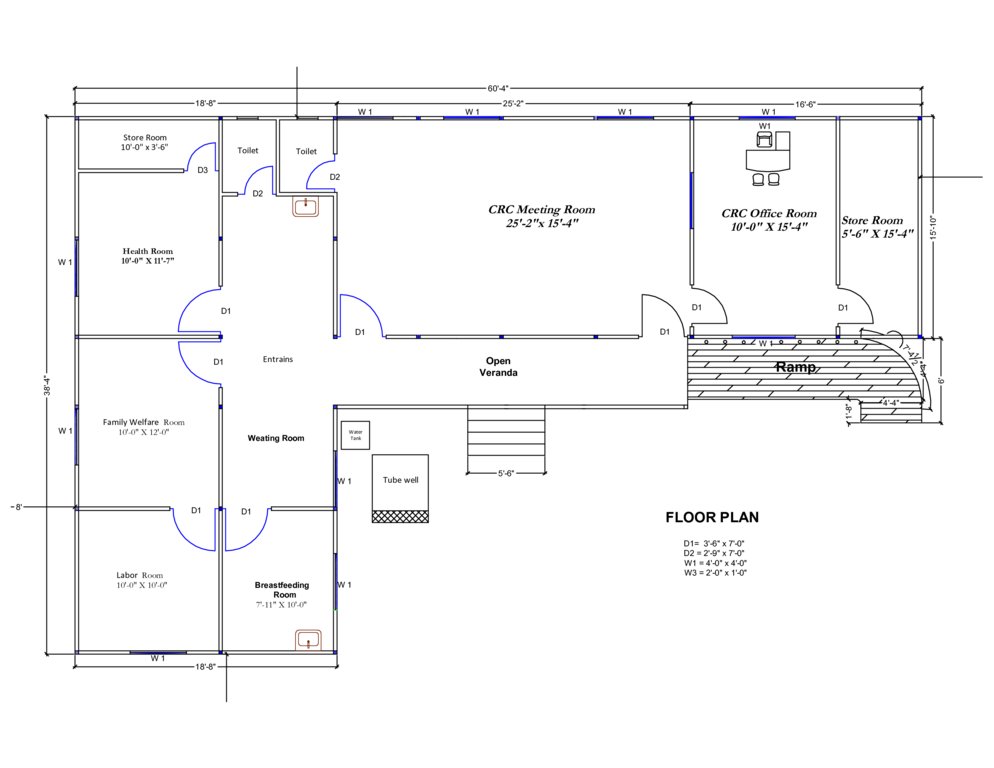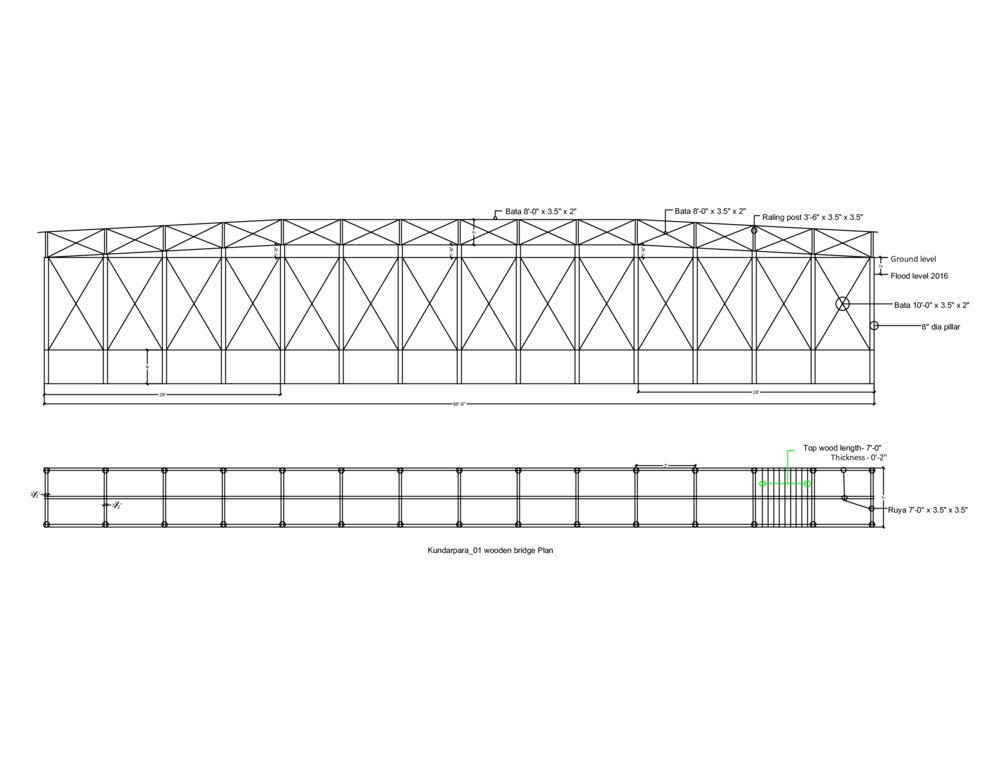Emergency infrastructure including shelter and linked transport infrastructure [ប្រទេសបង់ក្លាដែស]
- ការបង្កើត៖
- បច្ចុប្បន្នភាព
- អ្នកចងក្រង៖ TUHIN SAMADDAR
- អ្នកកែសម្រួល៖ Anton Jöhr
- អ្នកត្រួតពិនិត្យច្រើនទៀត៖ Alexandra Gavilano, Hanspeter Liniger, Nicole Harari
দুর্যোগ সহনশীন অবকাঠামো উন্নয়ন (Durjog-shahonshil abokathamo unnayon)
technologies_664 - ប្រទេសបង់ក្លាដែស
- សង្ខេបជា PDF
- សេចក្តីសង្ខេបពេញលេញជាទម្រង់ PDF សម្រាប់បោះពុម្ព
- សេចក្តីសង្ខេបពេញលេញទម្រង់អ៊ីនធឺនេត
- សេចក្តីសង្ខេបពេញលេញ (មិនមានទម្រង់ជាក់លាក់)
- Emergency infrastructure, shelter and access: 28 ខែ មិនា ឆ្នាំ 2017 (inactive)
- Emergency infrastructure including shelter and linked transport infrastructure: 2 ខែ សីហា ឆ្នាំ 2017 (inactive)
- Emergency infrastructure including shelter and linked transport infrastructure: 10 ខែ វិច្ឆិកា ឆ្នាំ 2017 (inactive)
- Emergency infrastructure including shelter and linked transport infrastructure: 5 ខែ មិនា ឆ្នាំ 2019 (public)
ពិនិត្យមើលគ្រប់ផ្នែក
ពង្រីកមើលទាំងអស់ បង្រួមទាំងអស់1. ព័ត៌មានទូទៅ
1.2 ព័ត៌មានលម្អិតពីបុគ្គលសំខាន់ៗ និងស្ថាប័នដែលចូលរួមក្នុងការវាយតម្លៃ និងចងក្រងឯកសារនៃបច្ចេកទេស
បុគ្គលសំខាន់ម្នាក់ (ច្រើននាក់)
Project Staff:
Mustafa Golam
Bangladesh Red Crescent Society
ប្រទេសបង់ក្លាដែស
Project Staff:
Razzak Abdur
Bangladesh Red Crescent Society
ប្រទេសបង់ក្លាដែស
Project Staff:
Islam Saiful
Bangladesh Red Crescent Society
ប្រទេសបង់ក្លាដែស
ឈ្មោះគម្រោងដែលបានចងក្រងឯកសារ/ វាយតម្លៃលើបច្ចេកទេស (បើទាក់ទង)
Book project: where people and their land are safer - A Compendium of Good Practices in Disaster Risk Reduction (DRR) (where people and their land are safer)ឈ្មោះអង្គភាពមួយ (ច្រើន) ដែលបានចងក្រងឯកសារ/ វាយតម្លៃបច្ចេកទេស (បើទាក់ទង)
Swiss Red Cross (Swiss Red Cross) - ប្រទេសស្វ៊ីស1.3 លក្ខខណ្ឌទាក់ទងទៅនឹងការប្រើប្រាស់ទិន្នន័យដែលបានចងក្រងតាមរយៈ វ៉ូខេត
អ្នកចងក្រង និង(បុគ្គលសំខាន់ៗ)យល់ព្រមទទួលយកនូវលក្ខខណ្ឌនានាទាក់ទងទៅនឹងការប្រើប្រាស់ទិន្នន័យដែលបានចងក្រងតាមរយៈវ៉ូខេត:
បាទ/ចា៎
1.4 សេចក្តីប្រកាសស្តីពីចីរភាពនៃការពណ៌នាពីបច្ចេកទេស
តើបច្ចេកទេសដែលបានពណ៌នានេះមានបញ្ហាដែលផ្តោតលើការធ្លាក់ចុះគុណភាពដី, បើដូច្នេះវាមិនអាចត្រូវបានប្រកាសថាជាបច្ចេកទេសនៃការគ្រប់គ្រងប្រកបដោយចីរភាពទេ?
ទេ
មតិយោបល់:
The technology presented has no direct bearing on land degradation.
1.5 ការយោងទៅលើកម្រងបញ្ជីសំណួរ (មួយ ឬច្រើន) នៃវិធីសាស្ត្រផ្សព្វផ្សាយ SLM (ដែលបានចងក្រងដោយទស្សនៈពិភពលោកស្តីពីវិធីសាស្ត្រ និងបច្ចេកទេសងអភិរក្ស WOCAT)
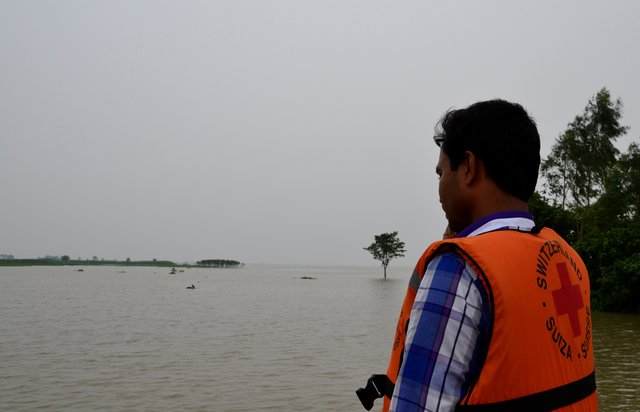
Early Warning Message Dissemination [ប្រទេសបង់ក្លាដែស]
An effective system for dissemination of early warning messages was established among the vulnerable communities in Chars (riverine sandy islands) of Gaibandha district, Bangladesh, in order to strengthen their coping mechanisms and reduce loss and damage caused by floods.
- អ្នកចងក្រង៖ TUHIN SAMADDAR
2. ការពណ៌នាពីបច្ចេកទេស SLM
2.1 ការពណ៌នាដោយសង្ខេបពីបច្ចេកទេស
និយមន័យបច្ចេកទេស:
Emergency infrastructure including shelter and linked transport infrastructure, consists in establishing specific flood shelters (for people and animals) including flood-proof collective water sources and communication infrastructure as well as health and school facilities that may serve at the same time as emergency shelters during floods.
2.2 ការពណ៌នាលម្អិតពីបច្ចេកទេស
ការពណ៌នា:
The technology applies to the specific context of the ‘Char’ land in Bangladesh, characterised as riverine sandy Islands along the Jamuna River. More than 80% of the land in the intervention area can be classified as 'Char' and is inhabited by 60% of the population served by the project. Every year, especially during floods, the rivers deposit huge amount of silt sediment that makes the land fertile. At the same time, river action washes away some portion of the 'Char' which at times can be quite large and has a strong impact on people's lives and livelihoods. Before the intervention, people living on 'Char' land depended on their traditional early warning mechanisms and were frequently surprised by floods that destroyed their crops and put their lives in danger. Due to recurring floods, people didn’t have the means to improve their built environment. The 'Char' land is furthermore characterised by its lack of public infrastructure and remoteness to public services.
The technology consists of setting up an emergency infrastructure and ensuring community access to these infrastructures during times of floods. It has to be understood in close interrelation with the approach of setting up an early warning system. The emergency infrastructure includes specific flood shelters (for people and animals), flood-proof collective water sources and sanitation systems, transport infrastructure such as foot bridges and elevated rural roads, as well as flood-proof health and school facilities that also serve as emergency shelters during floods. The flood shelters are built on a raised bed of soil and located at sites selected by the communities that are relatively better protected from flood and river erosion within the 'Chars'. The purpose of the technology is to ensure safety of life and protection of assets during times of emergency and also to mitigate sufferings related to floods. The flood shelter is an elevated plane land which is on an average 220 square feet by size and at least five feet high from the existing ground level. The site is selected by the community and should be connected through an elevated road to the nearest community. This arrangement helps people to get easy access during times of floods. The shelter has collective hygienic latrine facilities and safe water sources. People generally dismantle their housing while evacuating and reinstall it on the flood shelter.
The major activities include facilitating the development of community-led risk reduction action plans and their implementation through community participation and engagement of local governance institutions. This includes maintenance of the built infrastructure as the joint responsibility of the community and the local government. Land use, especially sowing and harvesting, is increasingly linked to flood related forecasting measures which has led to significant adaptation in the timing of farming activities. This coupled with the creation and access to emergency infrastructure allows for a relatively safe and healthy living. The adopted technology and approach has led to adapted livelihoods, reduced health costs and increased income. The technology has furthermore led to mainstreaming disaster risk management in policies and approach of local government institutions. Increasingly the local government’s cash and food for work programmes are targeting establishment and/or reinforcement of emergency infrastructure that can cater to larger population. Increased investments are made especially towards flood shelters and improving communication and access to emergency infrastructure. Since the technology is based on local knowledge and has been developed in consultation with the involved communities, it is generally well accepted with a fair degree of ownership and involvement. However, parts of the region are also prone to river erosion and this has a destructive impact on built infrastructures. The technology does not assure any safeguard against this form of uncertain river action.
2.3 រូបភាពនៃបច្ចេកទេស
កំណត់សម្គាល់ទូទៅនៃរូបថត/រូភាព:
Glimpse of few technologies that served as emergency infrastructure, shelter and access to health and water and sanitation facilities.
2.5 ប្រទេស/តំបន់/ទីតាំងកន្លែង ដែលបច្ចេកទេសត្រូវបានអនុវត្ត និងបានគ្រប់ដណ្តប់ដោយការវាយតម្លៃនេះ
ប្រទេស:
ប្រទេសបង់ក្លាដែស
តំបន់/រដ្ឋ/ខេត្ត:
North-Bengal
បញ្ជាក់បន្ថែមពីលក្ខណៈនៃទីតាំង:
Kamarjani and Mollar Char Union (i.e. municipality) in Sadar Upazila and Haldia Union in Shaghata Upazila of Gaibandha District
បញ្ជាក់ពីការសាយភាយនៃបច្ចេកទេស:
- ត្រូវបានផ្សព្វផ្សាយត្រឹមតំបន់មួយ
ប្រសិនបើមិនច្បាស់ពីទំហំផ្ទៃដី សូមធ្វើការប៉ាន់ប្រម៉ាណ:
- 1-10 គម2
មតិយោបល់:
Since the disaster resilient infrastructure set up by the project is installed at a huge number of sites (as indicated in the description above), only a sample of the various emergency infrastructures are indicated on the map above (If needed a comprehensive GPS reading of all infrastructure built by the project can be provided separately).
Though emergency infrastructures are built at specific sites, their use and benefits are evenly spread over an expanded area.
Map
×2.6 កាលបរិច្ឆេទនៃការអនុវត្ត
បង្ហាញឆ្នាំនៃការចុះអនុវត្ត:
2014
ប្រសិនបើមិនច្បាស់ឆ្នាំ សូមបញ្ជាក់កាលបរិច្ឆេទដែលប្រហាក់ប្រហែល:
- តិចជាង 10ឆ្នាំមុន (ថ្មី)
2.7 ការណែនាំពីបច្ចេកទេស
សូមបញ្ជាក់តើបច្ចេកទេសត្រូវបានណែនាំឱ្យអនុវត្តដោយរបៀបណា:
- ជាផ្នែកនៃប្រព័ន្ធប្រពៃណី (> 50 ឆ្នាំ)
- តាមរយៈគម្រោង / អន្តរាគមន៍ពីខាងក្រៅ
មតិយោបល់ (ប្រភេទនៃគម្រោង ។ល។):
The technology has elements of traditional practice (raised plinths for flood protection) and project promoted interventions (emergency shelter and access infrastructure).
3. ចំណាត់ថ្នាក់នៃបច្ចេកទេស SLM
3.1 គោលបំណងចម្បង (១ ឬច្រើន) នៃបច្ចេកទេសនេះ
- កាត់បន្ថយហានិភ័យនៃគ្រោះមហន្តរាយ
- បង្កើតផលប្រយោជន៍សេដ្ឋកិច្ច
- បង្កើតផលប្រយោជន៍សង្គម
3.2 ប្រភេទដីប្រើប្រាស់មួយប្រភេទ (ច្រើនប្រភេទ) ដែលបានអនុវត្តបច្ចេកទេស

ដីដាំដំណាំ
- ដំណាំប្រចាំឆ្នាំ
- ដំណាំរយៈពេលវែង (មិនមែនឈើ)
ដំណាំប្រចាំឆ្នាំ - បញ្ជាក់ប្រភេទដំណាំ:
- ធញ្ញជាតិ - ពោត
- ធញ្ញជាតិ - ផ្សេងៗ
- ធញ្ញជាតិ - ស្រូវ (តំបន់ដីសើម)
- ធញ្ញជាតិ - ស្រូវសាលី (សិសិររដូវរងារ)
- ពពួកសណ្តែក - ផ្សេងៗ
- ឬស/ដំណាំមើម - ដំឡូងជ្វា ពពួកដំឡូង ត្រាវ ផ្សេងៗ
- បន្លែ - បន្លែយកស្លឹក (សាលាដ ស្ពៃក្តោប ផ្ទី ផ្សេងៗ)
- Kharif and Rabi (Cereals)
ដំណាំរយៈពេលវែង (មិនមែនឈើ) - បញ្ជាក់ប្រភេទដំណាំ:
- រុក្ខជាតិឱសថ/ រុក្ខជាតិមានក្លិនក្រអូប/ រុក្ខជាតិការពារពីសត្វល្អិត - មានរយៈពេលវែង
ចំនួនសារដែលដាំដំណាំក្នុងមួយឆ្នាំ:
- 3
សូមបញ្ជាក់:
Kharif (monsoon crop), Rabi (winter crop), and Summer/pre-monsoon crop

ដីសម្រាប់ចិញ្ចឹមសត្វ
- Every household have at least a pair or more of livestock.
ប្រភេទសត្វ:
- សត្វក្របី
- សត្វពាហនៈ - សត្វចិញ្ចឹមមិនយកទឹកដោះតែសម្រាប់យកសាច់
- សត្វពាហនៈ - សត្វចិញ្ចឹមមិនយកទឹកដោះតែសម្រាប់យកកម្លាំងពលកម្ម
- សត្វពពែ
- សត្វលា
- សត្វចៀម
តើជាការអនុវត្តការគ្រប់គ្រងដែលរួមបញ្ចូលការដាំដំណាំ និងចិញ្ចឹមសត្វដែរឬទេ?
ទេ

លំនៅដ្ឋាន ហេដ្ឋារចនាសម្ព័ន្ធ
- ដីលំនៅស្ថាន អគារ
- ចរាចរណ៍៖ ផ្លូវថ្នល់ ផ្លូវដែក
មតិយោបល់:
Despite the lack of public infrastructure and services and being exposed to natural hazards people tend to prefer to live in the 'Char' as it brings significant economic benefits for them: crops grow rapidly and abundantly with significantly lower input costs than on the mainland.
Cow, buffalo, goat, lamb and donkey are very common in the area. People rear these for cultivation, transportation and for having meat. Every household have at least a pair or more of livestock.
3.4 ការផ្គត់ផ្គង់ទឹក
ការផ្គត់ផ្គង់ទឹកនៅកន្លែងអនុវត្តបច្ចេកទេស:
- ទឹកភ្លៀង និងប្រព័ន្ធស្រោចស្រព
មតិយោបល់:
Water supply for the land comprises a mix of rainfed, irrigated and post flooding sources.
3.5 ក្រុម SLM ដែលបច្ចេកទេសស្ថិតនៅក្នុង
- Emergency infrastructure, shelter and linked transportation infrastructure
3.6 វិធានការ SLM ដែលបញ្ចូលនូវបច្ចេកទេស

វិធានការរចនាស័ម្ពន្ធ
- S9: រោងដំណាំ និងរោងចិញ្ចឹមសត្វ
- S11: ផ្សេងៗ

វិធានការគ្រប់គ្រង
- M4: ការផ្លាស់ប្តូរចម្បងៗក្នុងការកំណត់ ពេលអនុវត្តសកម្មភាព
មតិយោបល់:
In addition to the structural and management measures described above, the technology involves additional elements such as flood-proof collective water supply and sanitation systems and communication infrastructure.
3.7 កំណត់ប្រភេទនៃការធ្លាក់ចុះគុណភាពដីសំខាន់ៗដែលបច្ចេកទេសនេះបានដោះស្រាយ

ការហូរច្រោះដីដោយសារទឹក
- Wr: សំណឹកដីច្រាំងទន្លេ
- Wo: ផលប៉ះពាល់នៃការធ្លាក់ចុះគុណភាពកន្លែងឆ្ងាយ
មតិយោបល់:
N/A
3.8 ការពារ កាត់បន្ថយ ឬស្តារឡើងវិញនៃការធ្លាក់ចុះគុណភាពដី
បញ្ជាក់ពីគោលដៅរបស់បច្ចេកទេស ដែលផ្តោតទៅការធ្លាក់ចុះគុណភាពដី:
- ការបន្ស៊ាំទៅនឹងការធ្លាក់ចុះគុណភាពដី
មតិយោបល់:
NA
4. បច្ចេកទេសជាក់លាក់ សកម្មភាពអនុវត្ត ធាតុចូល និងថ្លៃដើម
4.1 គំនូសបច្ចេកទេសនៃបច្ចេកទេសនេះ
លក្ខណៈពិសេសនៃបច្ចេកទេស (ទាក់ទងនឺងគំនូរបច្ចេកទេស):
The built structural mitigation options have following technical specification:
1. Flood shelter: Dimension: Length-220' x Width-220' x Height- 5.5', Slope: 1:1.5, Capacity: 350 families, Construction material used: soil and turfing (grass)
2. Raised school compound: Dimension: Length-112' x Width-75' x Height- 5.5', Slope: 1:1.5, Capacity: 540 person, Construction material used: soil and turfing (grass)
3. Community Resource Centre and Community Clinic (CRC-CC): Dimension: Length-60' x Width-38' x Height- 5.6', Slope: 1:1.5, Capacity: 1500 families from 5 villages, Construction material used: soil and grass plantation, bricks, sand, cement, rod, iron angel and CGI sheet.
4. Disaster resilient tube well: Dimension: Length-5' 10" x Width-5' x Height- 3', Boring: 100 feet, Capacity: 200 families, Construction material used: bricks, sand, cement, rod, tube well head, pvc pipe, cylinder, piston rod etc. Vertical intervals: 2 in each village.
5. Concrete platform for (existing) tube well: Dimension: Length-4' 10" x Width-4' x Height- 1', Capacity: 100 families, Construction material used: bricks, sand, cement, pvc pipe
6. Wooden bridge: Dimension: Length-99' x Width-7' x Height- 12', Slope: 1:1.5, Capacity: 900 families approximately, Construction material used: wood, nails, tar, soil and grass plantation
7. Road construction/repair: Dimension: Length-925' x Width-12' x Height- 3' (from existing level), Slope: 1:1.5, Capacity: 3 villages (approx:1000 families), Construction material used: soil and turfing (grass).
ឈ្មោះអ្នកនិពន្ធ:
Abdur Razzak
កាលបរិច្ឆេទ:
17/10/2016
4.2 ព័ត៌មានទូទៅដែលពាក់ព័ន្ធនឹងការគណនាធាតុចូល និងថ្លៃដើម
កំណត់របៀបនៃការគណនាថ្លៃដើម និងធាតុចូល:
- ក្នុងឯកតាបច្ចេកទេស
បញ្ជាក់ឯកតា:
flood shelter, raised school compound, disaster resilient tube well, concrete platform for (existing) tube well, wooden bridge, road construction/repair
បញ្ជាក់ពីទំហំនៃឯកតា (បើពាក់ព័ន្ធ):
road: per meter
ផ្សេងៗ/ រូបិយប័ណ្ណជាតិ (បញ្ជាក់):
Bangladeshi Taka (BDT)
បើពាក់ព័ន្ធសូមកំណត់អត្រាប្តូរប្រាក់ពីដុល្លាទៅរូបិយប័ណ្ណតំបន់ (ឧ. 1 ដុល្លារ = 79.9 រៀលនៃរូបិយប័ណ្ណប្រេស៊ីល) ៖ 1 ដុល្លារ =:
79,0
កំណត់ថ្លៃឈ្នួលជាមធ្យមនៃការជួលកម្លាំងពលកម្មក្នុងមួយថ្ងៃ:
350 BDT
4.3 សកម្មភាពបង្កើត
| សកម្មភាព | រយៈពេល (រដូវកាល) | |
|---|---|---|
| 1. | Construction of Flood Shelter | During dry season |
| 2. | Raising school compound | During dry season |
| 3. | Construction of Community Resource Center (CRC) | During dry season |
| 4. | Installation of disaster resilient tube well | During dry season |
| 5. | Construction of concrete platform for (existing) tube well | During dry season |
| 6. | Construction of wooden bridge | During dry season |
| 7. | Road construction above flood level | During dry season |
មតិយោបល់:
All activities are structural in nature and can be undertaken efficiently only in dry season.
4.4 ថ្លៃដើម និងធាតុចូលដែលត្រូវការសម្រាប់ការបង្កើតបច្ចេកទេស
| បញ្ជាក់ពីធាតុចូល | ឯកតា | បរិមាណ | ថ្លៃដើមក្នុងមួយឯកតា | ថ្លៃធាតុចូលសរុប | % នៃថ្លៃដើមដែលចំណាយដោយអ្នកប្រើប្រាស់ដី | |
|---|---|---|---|---|---|---|
| កម្លាំងពលកម្ម | Flood shelter: earth work | m3 | 8000,0 | 64,0 | 512000,0 | 10,0 |
| កម្លាំងពលកម្ម | CRC: earth work | m3 | 53,0 | 138,0 | 7314,0 | 10,0 |
| កម្លាំងពលកម្ម | CRC: sand filling | m3 | 302,0 | 99,0 | 29898,0 | 10,0 |
| កម្លាំងពលកម្ម | Raised school compound: earth work | m3 | 1790,0 | 64,0 | 114560,0 | 10,0 |
| សម្ភារៈដាំដុះ | Flood shelter: grass plantation (turfing) | m2 | 4620,0 | 13,0 | 60060,0 | 10,0 |
| សម្ភារៈដាំដុះ | Flood shelter: seedlings | piece | 20,0 | 53,0 | 1060,0 | 10,0 |
| សម្ភារៈដាំដុះ | CRC: grass plantation (turfing) | m2 | 3890,0 | 13,0 | 50570,0 | 10,0 |
| សម្ភារៈដាំដុះ | CRC: seedlings | piece | 50,0 | 53,0 | 2650,0 | 10,0 |
| សម្ភារៈដាំដុះ | Raised school compound: grass plantation (turfing) | m2 | 1390,0 | 13,0 | 18070,0 | 10,0 |
| សម្ភារៈដាំដុះ | Raised school compound: seedlings | piece | 40,0 | 53,0 | 2120,0 | 10,0 |
| សម្ភារៈសាងសង់ | CRC: roof truss | kg | 4375,0 | 100,0 | 437500,0 | |
| សម្ភារៈសាងសង់ | CRC: grill and iron work | m2 | 88,0 | 2091,0 | 184008,0 | |
| សម្ភារៈសាងសង់ | CRC: gypsum board | m2 | 478,0 | 922,0 | 440716,0 | |
| សម្ភារៈសាងសង់ | CRC: RCC work | m3 | 2,9 | 19557,0 | 56715,3 | |
| សម្ភារៈសាងសង់ | CRC: deformed bar | kg | 397,0 | 85,0 | 33745,0 | |
| សម្ភារៈសាងសង់ | CRC: boundary fencing | m2 | 184,0 | 440,0 | 80960,0 | |
| សម្ភារៈសាងសង់ | CRC: brick work | m3 | 44,0 | 5515,0 | 242660,0 | |
| ផ្សេងៗ | CRC: electric ware and solar panel | lumpsum | 1,0 | 73000,0 | 73000,0 | |
| ផ្សេងៗ | CRC: water supply | lumpusm | 1,0 | 66150,0 | 66150,0 | |
| ផ្សេងៗ | CRC: transportation | lumpsum | 1,0 | 89000,0 | 89000,0 | |
| ថ្លៃដើមសរុបក្នុងការបង្កើតបច្ចេកទេស | 2502756,3 | |||||
| ថ្លៃដើមសរុបក្នុងការបង្កើតបច្ចេកទេសគិតជាដុល្លារ | 31680,46 | |||||
ប្រសិនបើអ្នកប្រើប្រាស់ដីមិនមានថ្លៃដើម 100% សូមបញ្ជាក់ថានរណាដែលចំណាយថ្លៃដើមដែលនៅសល់:
10% of all construction cost (except community resource center) is borne by the user. Another 15% is provided by the local government bodies. The remaining 75% is subsidised by the project.
មតិយោបល់:
Defining costs of establishment is bit tricky as the measures differ in size and number, costs vary from one village to another depending on the geographical location. However, average costs of the measures further to those highligted in the table are given below:
Disaster resilient tube well: labour (mason) 3'000, equipment (drilling charge) 1800, construction material (bricks, cement, sand, iron rod, PVC pipe, cylinder, GI pipe, tubewell head) 23'250, transportation 2'650, total unit costs (BDT) 30'700
Concrete platform for (existing) tube well : labour (mason) 600, construction material (bricks, cement, sand) 2'450, other (Transportation, waste water disposal) 1650, total unit costs (BDT) 4'700
Wooden bridge: labour (mason, mason assitant, painting assistant, earthwork) 30'000, plant material (grass plantation) 12'500, equipment (painting brush etc.) 1'000, construction material (timber, nails, tar, tarpin oil, paint) 260'000, Transportation 30'000, total unit costs (BDT) 333'500
Road construction/repair: labour (earthwork) 102'500, plant material (grass plantation/turfing), 12'500, total unit costs (BDT) 115'000
4.5 សកម្មភាពថែទាំ
| សកម្មភាព | ពេលវេលា/ ភាពញឹកញាប់ | |
|---|---|---|
| 1. | Construction of Flood Shelter | During dry season |
| 2. | Raising school compound | During dry season |
| 3. | Construction of Community Resource Center (CRC) | During dry season |
| 4. | Installation of disaster resilient tube well | During dry season |
| 5. | Construction of concrete platform ror (existing) tube well | During dry season |
| 6. | Construction of wooden bridge | During dry season |
| 7. | Road construction above flood level | During dry season |
មតិយោបល់:
Due to the softness of the sandy soil and the annual inundation, every measure requires considerable maintenance. The flooding generally washes out sands and decays the foundation of the structure. If maintenance is done in regular intervals, the entire structure remains functional. Also, grass needs to be frequently replanted as it dries up during the dry season.
The users and the local government (Union Disaster Management Committee) are mainly responsible for maintenance of all built assets and structures including the Community Resource Center. The relevant operation/repair and maintenance training has been provided by the project.. Maintenance manuals and guidelines have been developed and disseminated. Also, repair and maintenance equipment has been provided to cadre of users/caretakers trained in repair/maintenance work.
4.6 កំណត់ថ្លៃដើមសម្រាប់ការថែទាំ/ សកម្មភាពរបស់បច្ចេកទេស (ក្នុងរយៈពេលមួយឆ្នាំ)
| បញ្ជាក់ពីធាតុចូល | ឯកតា | បរិមាណ | ថ្លៃដើមក្នុងមួយឯកតា | ថ្លៃធាតុចូលសរុប | % នៃថ្លៃដើមដែលចំណាយដោយអ្នកប្រើប្រាស់ដី | |
|---|---|---|---|---|---|---|
| កម្លាំងពលកម្ម | Earthwork | m3 | 80,0 | 63,0 | 5040,0 | 10,0 |
| កម្លាំងពលកម្ម | Sand bag filling | piece | 50,0 | 15,0 | 750,0 | 10,0 |
| កម្លាំងពលកម្ម | Pipe fitting | piece | 2,0 | 300,0 | 600,0 | 10,0 |
| កម្លាំងពលកម្ម | Mason | lumpsum | 1,0 | 500,0 | 500,0 | 10,0 |
| សម្ភារៈដាំដុះ | Grass plantation (turfing) | m2 | 85,0 | 13,0 | 1105,0 | 10,0 |
| សម្ភារៈដាំដុះ | Seedlings | piece | 15,0 | 53,0 | 795,0 | 10,0 |
| សម្ភារៈសាងសង់ | Plastic bag | piece | 50,0 | 10,0 | 500,0 | 10,0 |
| សម្ភារៈសាងសង់ | PVC pipe | m | 15,0 | 120,0 | 1800,0 | 10,0 |
| សម្ភារៈសាងសង់ | Polythene pipe | kg | 5,0 | 160,0 | 800,0 | 10,0 |
| សម្ភារៈសាងសង់ | Ciment | bag | 0,5 | 540,0 | 270,0 | 10,0 |
| សម្ភារៈសាងសង់ | Sand | ft3 | 5,0 | 18,0 | 90,0 | 10,0 |
| សម្ភារៈសាងសង់ | Caping socket | piece | 2,0 | 35,0 | 70,0 | 10,0 |
| សម្ភារៈសាងសង់ | Tape etc. | lumpsum | 1,0 | 250,0 | 250,0 | 10,0 |
| ថ្លៃដើមសរុបសម្រាប់ការថែទាំដំណាំតាមបច្ចេកទេស | 12570,0 | |||||
| ថ្លៃដើមសរុបសម្រាប់ការថែទាំដំណាំតាមបច្ចេកទេសគិតជាដុល្លារ | 159,11 | |||||
ប្រសិនបើអ្នកប្រើប្រាស់ដីមិនមានថ្លៃដើម 100% សូមបញ្ជាក់ថានរណាដែលចំណាយថ្លៃដើមដែលនៅសល់:
Maintenance costs are to date (2017) distributed as construction (10% by the users, 15% by the local government). A cost transfer scheme to the users and local government for maintenance is developped to be applied in the follow-up phase.
មតិយោបល់:
Again, defining costs of maintenance is also not easy as the measures differ in size and number. Average costs of the measures, further to those for flood shelter including disaster resilient tube well as highligted in the table, are given below:
Raised school compound: labour (earth work and sand bag filling) 7'800, plant material (grass plantation) 1'000, construction material (plastic bag, rope) 500, total unit maintenance costs (BDT) 9'300
Community resource Center (CRC): labour 1'200, plant material (grass plantation, seedlings) 10'500, Transportation 1'000, total unit maintenance costs (BDT) 12'700
Concrete platform for (existing) tube well : labour (mason) 500, construction material (bricks, cement, sand) 600, total unit maintenance costs (BDT) 1'100
Wooden bridge: labour (earthwork) 2'500, plant material (grass plantation) 3'000, construction material (plastic bag, rope) 2'000, total unit maintenance costs (BDT) 7'500
Road construction/repair: labour (earthwork) 10'000, plant material (grass plantation/turfing), 1'500, construction material (plastic bag, rope) 500, total unit maintenance costs (BDT) 12'000
4.7 កត្តាសំខាន់បំផុតដែលមានឥទ្ធិពលដល់ការចំណាយ
ពណ៌នាពីកត្តាប៉ះពាល់ចម្បងៗទៅលើថ្លៃដើម:
Transportation of raw material from the mainland to the sites on the 'Char' Islands varies across seasons. In the dry season it is much higher compared to monsoon as the delivery of material is easier in the latter due to extended river outreach.
5. លក្ខណៈបរិស្ថានធម្មជាតិ និងមនុស្ស
5.1 អាកាសធាតុ
បរិមាណទឹកភ្លៀងប្រចាំឆ្នាំ
- < 250 មម
- 251-500 មម
- 501-750 មម
- 751-1,000 មម
- 1,001-1,500 មម
- 1,501-2,000 មម
- 2,001-3,000 មម
- 3,001-4,000 មម
- > 4,000 មម
កំណត់បរិមាណទឹកភ្លៀង (បើដឹង) ជា មីលីម៉ែត្រ:
2134,80
លក្ខណៈពិសេស/ មតិយោបល់លើរដូវភ្លៀង:
Rainy season: April- October
Occurrence of heavy rain: June-July
Length of dry period: November-March
បញ្ជាក់ឈ្មោះឯកសារយោងនៃស្ថានីយឧតុនិយម:
18 Gaibandha Sadar, Gaibandha
តំបន់កសិអាកាសធាតុ
- សើម
Tropical humid climatic zone.
Temperature: maximum 33.5°C, minimum 10.5°C
5.2 សណ្ឋានដី
ជម្រាលជាមធ្យម:
- រាបស្មើ (0-2%)
- ជម្រាលតិចតួច (3-5%)
- មធ្យម (6-10%)
- ជម្រាលខ្ពស់បន្តិច (11-15%)
- ទីទួល (16-30%)
- ទីទួលចោត (31-60%)
- ទីទួលចោតខ្លាំង (>60%)
ទម្រង់ដី:
- ខ្ពង់រាប
- កំពូលភ្នំ
- ជម្រាលភ្នំ
- ជម្រាលទួល
- ជម្រាលជើងភ្នំ
- បាតជ្រលងភ្នំ
តំបន់តាមរយៈកម្ពស់ :
- 0-100 ម
- 101-500 ម
- 501-1,000 ម
- 1,001-1,500 ម
- 1,501-2,000 ម
- 2,001-2,500 ម
- 2,501-3,000 ម
- 3,001-4,000 ម
- > 4,000 ម
បញ្ជាក់ថាតើបច្ចេកទេសនេះត្រូវបានអនុវត្តន៍នៅក្នុង:
- មិនពាក់ព័ន្ធទាំងអស់
មតិយោបល់ និងបញ្ចាក់បន្ថែមអំពីសណ្ឋានដី :
Information on altitudinal zone collected from the website: www.getamap.net
5.3 ដី
ជម្រៅដីជាមធ្យម:
- រាក់ខ្លាំង (0-20 សម)
- រាក់ (21-50 សម)
- មធ្យម (51-80 សម)
- ជ្រៅ (81-120 សម)
- ជ្រៅខ្លាំង (> 120 សម)
វាយនភាពដី (ស្រទាប់លើ):
- មធ្យម (ល្បាយ, ល្បាប់)
- ម៉ត់/ ធ្ងន់ (ឥដ្ឋ)
វាយនភាពដី (> 20 សម ស្រទាប់ក្នុង):
- គ្រើម/ មានពន្លឺ (ខ្សាច់)
- មធ្យម (ល្បាយ, ល្បាប់)
សារធាតុសរីរាង្គនៅស្រទាប់ដីខាងលើ:
- មធ្យម (1-3%)
បើអាចសូមភ្ជាប់ការពណ៌នាពីដីឱ្យបានច្បាស់ ឬព័ត៌មានដែលអាចទទួលបាន ឧ. ប្រភេទដី, pH ដី/ ជាតិអាស៊ីត, សមត្ថភាពផ្លាស់ប្តូរកាចុង, វត្តមាននីត្រូសែន, ភាពប្រៃ ។ល។:
N/A
5.4 ទឹកដែលអាចទាញមកប្រើប្រាស់បាន និងគុណភាពទឹក
នីវ៉ូទឹកក្រោមដី:
5-50 ម
ទឹកលើដីដែលអាចទាញយកប្រើប្រាស់បាន:
កម្រិតមធ្យម
គុណភាពទឹក (មិនបានធ្វើប្រត្តិកម្ម):
ទឹកពិសារដែលមានគុណភាពល្អ
តើមានបញ្ហាភាពទឹកប្រៃហូរចូលមកដែរឬទេ?
ទេ
តើទឹកជំនន់កំពុងកើតមាននៅតំបន់នេះដែររឺទេ?
បាទ/ចា៎
ភាពទៀងទាត់:
ញឹកញាប់
មតិយោបល់ និងលក្ខណៈពិសេសផ្សេងៗទៀតលើគុណភាព និងបរិមាណទឹក :
In the dry season water crisis occurs. Open defecation and use of pesticide in farming are key pollutants of water sources.
5.5 ជីវៈចម្រុះ
ភាពសម្បូរបែបនៃប្រភេទ:
- កម្រិតមធ្យម
ភាពសម្បូរបែបនៃទីជម្រក:
- កម្រិតមធ្យម
មតិយោបល់ និងលក្ខណៈពិសេសផ្សេងទៀតលើជីវចម្រុះ:
Biodiversity can be rated as moderate or medium both in terms of species and habitat. It is stable and and often self generating.
5.6 លក្ខណៈនៃអ្នកប្រើប្រាស់ដីដែលអនុវត្តបច្ចេកទេស
នៅមួយកន្លែង ឬពនេចរ :
- នៅមួយកន្លែង
- ពាក់កណ្តាលពនេចរ
ទីផ្សារនៃប្រព័ន្ធផលិតកម្ម:
- ពាក់កណ្តាលពាណិជ្ជកម្ម (ផ្គត់ផ្គង់ខ្លួនឯង/ ពាណិជ្ជកម្ម)
ចំណូលក្រៅកសិកម្ម:
- តិចជាង 10% នៃចំណូល
កម្រិតជីវភាព:
- មិនល្អ
ឯកជន ឬក្រុម:
- ធ្វើខ្លួនឯង/ គ្រួសារ
- ជាក្រុម/ សហគមន៍
កម្រិតប្រើប្រាស់គ្រឿងយន្ត:
- ប្រើកម្លាំងសត្វ
- គ្រឿងយន្ត/ ម៉ាស៊ីន
យេនឌ័រ:
- ស្ត្រី
- បុរស
អាយុរបស់អ្នកប្រើប្រាស់ដី:
- យុវវ័យ
- វ័យកណ្តាល
សូមបញ្ជាក់ពីលក្ខណៈពាក់ព័ន្ធផ្សេងទៀតអំពីអ្នកប្រើប្រាស់ដី:
N/A
5.7 ទំហំផ្ទៃដីជាមធ្យមនៃដីប្រើប្រាស់ដោយអ្នកប្រើប្រាស់ដី ក្នុងការអនុវត្តបច្ចេកទេស
- < 0.5 ហិកតា
- 0.5-1 ហិកតា
- 1-2 ហិកតា
- 2-5 ហិកតា
- 5-15 ហិកតា
- 15-50 ហិកតា
- 50-100 ហិកតា
- 100-500 ហិកតា
- 500-1,000 ហិកតា
- 1,000-10,000 ហិកតា
- > 10,000 ហិកតា
តើផ្ទៃដីនេះចាត់ទុកជាទំហំកម្រិតណាដែរ ខ្នាតតូច មធ្យម ឬខ្នាតធំ (ធៀបនឹងបរិបទតំបន់)?
- ខ្នាតតូច
មតិយោបល់:
People living in Chars have small landholding which often produces enough for subsistence and, in some cases, for market purposes.
5.8 ភាពជាម្ចាស់ដី កម្មសិទ្ធប្រើប្រាស់ដី និងកម្មសិទ្ធប្រើប្រាស់ទឹក
ភាពជាម្ចាស់ដី:
- រដ្ឋ
- ឯកជន មិនមានកម្មសិទ្ធ
កម្មសិទ្ធិប្រើប្រាស់ដី:
- អាស្រ័យផលសេរី (មិនមានការកំណត់)
- កិច្ចសន្យាជួល
កម្មសិទ្ធប្រើប្រាស់ទឹក:
- ជាក្រុម (មានដែនកំណត់)
- ឯកជន
មតិយោបល់:
Land ownership is quite complex as Chars by nature are unstable habitats. In principle land is owned by state but in most cases the politician - musclemen nexus exercises real control. This results in leasing and renting of land which is the predominant form of land ownership in Chars.
5.9 ការប្រើប្រាស់សេវាកម្ម និងហេដ្ឋារចនាសម្ព័ន្ធ
សុខភាព:
- មិនល្អ
- មធ្យម
- ល្អ
ការអប់រំ:
- មិនល្អ
- មធ្យម
- ល្អ
ជំនួយបច្ចេកទេស:
- មិនល្អ
- មធ្យម
- ល្អ
ការងារ (ឧ. ការងារក្រៅកសិដ្ឋាន):
- មិនល្អ
- មធ្យម
- ល្អ
ទីផ្សារ:
- មិនល្អ
- មធ្យម
- ល្អ
ថាមពល:
- មិនល្អ
- មធ្យម
- ល្អ
ផ្លូវ និងការដឹកជញ្ជូន:
- មិនល្អ
- មធ្យម
- ល្អ
ទឹកផឹក និងអនាម័យ:
- មិនល្អ
- មធ្យម
- ល្អ
សេវាកម្មហិរញ្ញវត្ថុ:
- មិនល្អ
- មធ្យម
- ល្អ
Access to mobile phone and internet:
- មិនល្អ
- មធ្យម
- ល្អ
6. ផលប៉ះពាល់ និងការសន្និដ្ឋាន
6.1 ផលប៉ះពាល់ក្នុងបរិវេណអនុវត្តបច្ចេកទេសដែលកើតមាន
ផលប៉ះពាល់លើសេដ្ឋកិច្ចសង្គម
ផលិតផល
ផលិតកម្មដំណាំ
គុណភាពមុន SLM:
3600 kg/hectare (maize)
គុណភាពក្រោយ SLM:
11400 kg/hectare (maize)
មតិយោបល់/ ការបញ្ជាក់:
Crop production has increased thrice due to stability of household which has led to stable use of land in the chars.
ទឹកដែលអាចទាញមកប្រើប្រាស់បាន និងគុណភាពទឹក
ទឹកបរិភោគដែលអាចទាញយកមកប្រើប្រាស់បាន
គុណភាពមុន SLM:
No safe drinking water source was available
គុណភាពក្រោយ SLM:
More than 40% water source are safe
មតិយោបល់/ ការបញ្ជាក់:
Collective water supply systems have groundwater sources and thus no treatment is needed. Further, aspects of availability, easy access and sustainable availability of sufficient water of acceptable quality are well considered. Families can access 10 litres per capita per day (LPCD) during emergencies (which is in line with Sphere standards) and during normal times 40 LPCD is what families can collect from these water sources. All such water sources are within a distance of 50 metres from the settlement as per Bangladesh standards.
គុណភាពទឹកបរិភោគ
គុណភាពមុន SLM:
Reliable data not available
គុណភាពក្រោយ SLM:
All households have access to safe drinking water as per govt. standard for rural areas
មតិយោបល់/ ការបញ្ជាក់:
The collective water infrastructure built by the project ensures fulfillment of minimum standards set by the govt for safe drinking water.
ចំណូល និងថ្លៃដើម
ចំណូលក្នុងកសិដ្ឋាន
គុណភាពមុន SLM:
25% families had farm income
គុណភាពក្រោយ SLM:
95% families have farm income
មតិយោបល់/ ការបញ្ជាក់:
Cattle and poultries are safe during disaster
ផលប៉ះពាល់ទៅលើវប្បធម៌សង្គម
ស្ថានភាពសុខភាព
មតិយោបល់/ ការបញ្ជាក់:
The disaster mitigation measures has significantly improved the health situation of the target population.
ស្ថាប័នសហគមន៍
គុណភាពមុន SLM:
Few credit groups in intervention villages
គុណភាពក្រោយ SLM:
30 community based organisatons (i.e. village disaster management committees) and 3 Local Government Committees (Union disaster management committee)
មតិយោបល់/ ការបញ្ជាក់:
Community based organisations and government mandated institutions have been promoted through project initiatives.
ស្ថាប័នជាតិ
មតិយោបល់/ ការបញ្ជាក់:
CRC is also being used for UDMC office which is an important committee of union parishad.
ការកាត់បន្ថយជម្លោះ
គុណភាពមុន SLM:
Widespread
គុណភាពក្រោយ SLM:
Rare
មតិយោបល់/ ការបញ្ជាក់:
Conflict sensitive approach has significantly reduced the incidence of conflicts.
ផលប៉ះពាល់ទៅលើអេកូឡូស៊ី
វដ្តទឹក/លំហូរ
បរិមាណទឹក
គុណភាពមុន SLM:
Data not available
គុណភាពក្រោយ SLM:
Same
មតិយោបល់/ ការបញ្ជាក់:
The disaster resilient tube well ensures year round drinking water.
ការកាត់បន្ថយហានិភ័យនៃគ្រោះមហន្តរាយ និងគ្រោះអាកាសធាតុ
ផលប៉ះពាល់នៃទឹកជំនន់
គុណភាពមុន SLM:
95% families were effected from flood
គុណភាពក្រោយ SLM:
47% families are affected from flood
មតិយោបល់/ ការបញ្ជាក់:
The above figures are from 2016 when Bangladesh experienced one of the worst floods in recent times.
6.2 ផលប៉ះពាល់ក្រៅបរិវេណអនុវត្តបច្ចេកទេសដែលកើតមាន
វាយតម្លៃផលប៉ះពាល់ក្រៅបរិវេណអនុវត្តបច្ចេកទេស (វាស់វែង):
N/A
6.3 ភាពប្រឈម និងភាពរួសនៃបច្ចេកទេសទៅនឹងការប្រែប្រួលអាកាសធាតុ និងគ្រោះអាកាសធាតុ/ គ្រោះមហន្តរាយ (ដែលដឹងដោយអ្នកប្រើប្រាស់ដី)
គ្រោះអាកាសធាតុ (មហន្តរាយ)
គ្រោះមហន្តរាយធម្មជាតិ
| លក្ខណៈឆ្លើយតបនៃបច្ចេកទេសទៅនឹងការប្រែប្រួលអាកាសធាតុ | |
|---|---|
| ព្យុះភ្លៀងតាមតំបន់ | មធ្យម |
| ព្យុះខ្សាច់តាមតំបន់ | ល្អ |
| ព្យុះកំបុតត្បូងតាមតំបន់ | ល្អ |
គ្រោះមហន្តរាយអាកាសធាតុ
| លក្ខណៈឆ្លើយតបនៃបច្ចេកទេសទៅនឹងការប្រែប្រួលអាកាសធាតុ | |
|---|---|
| រលកកម្តៅ | ល្អ |
| រលកត្រជាក់ | ល្អ |
| រាំងស្ងួត | ល្អ |
គ្រោះមហន្តរាយទឹក
| លក្ខណៈឆ្លើយតបនៃបច្ចេកទេសទៅនឹងការប្រែប្រួលអាកាសធាតុ | |
|---|---|
| ទឹកជំនន់ទូទៅ (ទន្លេ) | ល្អ |
| ដីបាក់ | មិនល្អ |
មតិយោបល់:
In some cases the appropriate answer would have been "not applicable" but since this is not there, we have selected "well".
6.4 ការវិភាគថ្លៃដើម និងអត្ថប្រយោជន៍
តើផលចំណេញ និងថ្លៃដើមត្រូវបានប្រៀបធៀបគ្នាយ៉ាងដូចម្តេច (ទស្សនៈរបស់អ្នកប្រើប្រាស់ដី)?
រយៈពេលខ្លី:
វិជ្ជមានខ្លាំង
រយៈពេលវែង:
វិជ្ជមាន
តើផលចំណេញ និងការថែទាំ/ ជួសជុលត្រូវបានប្រៀបធៀបគ្នាយ៉ាងដូចម្តេច (ទស្សនៈរបស់អ្នកប្រើប្រាស់ដី)?
រយៈពេលខ្លី:
វិជ្ជមាន
រយៈពេលវែង:
វិជ្ជមានតិចតួច
មតិយោបល់:
The limited returns that have been generated by the project is highly valued by the users from a cost - benefit perspective; especially when they understand that the project is not directly linked to land management practices. Thus, the indirect benefits are perceived to have high value.
6.5 ការទទួលយកបច្ចេកទេស
- > 50%
បើអាច សូមបញ្ជាក់ពីបរិមាណ (ចំនួនគ្រួសារ និង/ ឬតំបន់គ្របដណ្តប់):
Out of a total of 8828 HHs targeted by the project, around five thousand HHs in three union have benefitted from the implementation of the technology.
ក្នុងចំណោមគ្រួសារទាំងអស់ដែលបានអនុវត្តបច្ចេកទេស តើមានប៉ុន្មានគ្រួសារដែលចង់ធ្វើដោយខ្លួនឯង ដោយមិនទទួលបានសម្ភារៈលើកទឹកចិត្ត/ប្រាក់ឧបត្ថម្ភ?:
- 0-10%
6.6 ការបន្សុំា
តើថ្មីៗនេះ បច្ចេកទេសនេះត្រូវបានកែតម្រូវដើម្បីបន្ស៊ាំទៅនឹងស្ថានភាពប្រែប្រួលដែរឬទេ?
បាទ/ចា៎
បើឆ្លើយបាទ/ ចា៎ សូមកំណត់ថាតើស្ថានភាពប្រែប្រួលមួយណាត្រូវបានបន្ស៊ាំ:
- កម្លាំងពលកម្មដែលអាចរកបាន (ចំណាកស្រុក)
បញ្ជាក់ពីការបន្ស៊ាំនៃបច្ចេកទេស (ការរៀបចំ, ឧបករណ៍/ប្រភេទ ។ល។):
Dredging machine has been used for building some emergency infrastructure at few sites due to unavailability of labour at the time of construction.
6.7 ភាពខ្លាំង/ គុណសម្បត្តិ/ ឱកាសនៃបច្ចេកទេស
| ភាពខ្លាំង/ គុណសម្បត្តិ/ ឱកាសនៅកន្លែងរបស់អ្នកប្រើប្រាស់ដី |
|---|
| Emergency structures are collectively owned and have a multipurpose use; in 'normal' (non-emergency) times they are used for other purpose than safety and protection which includes community meeting, workshop and training |
| Expanded opportunities of communication during flood |
| ភាពខ្លាំង/ គុណសម្បត្តិ/ ឱកាស ទស្សនៈរបស់បុគ្គលសំខាន់ៗ |
|---|
| Community is aware and driven to implement flood preparedness and risk reduction measures on its own |
| Appropriate measures can significantly change people's mindset and behaviour |
6.8 ភាពខ្សោយ/ គុណវិបត្តិ/ ហានិភ័យនៃបច្ចេកទេស និងវិធីសាស្ត្រដោះស្រាយ
| ភាពខ្សោយ/ គុណវិបត្តិ/ ហានិភ័យ ទស្សនៈរបស់អ្នកប្រើប្រាស់ដី | តើបច្ចេកទេសទាំងនោះបានដោះស្រាយបញ្ហាដូចម្តេច? |
|---|---|
| River erosion threatens built structures | Careful site selection for construction work through in depth discussion with community people supported by scientific analysis |
| High investment needed for building physical structures (e.g. CRC building) in the char which the local government and community find difficult to finance without external support. | Install portable semi-permanent structures in the char; Lobby for greater decentralisation of finances to local government |
7. ឯកសារយោង និងវេបសាយ
7.1 វិធីសាស្ត្រ/ ប្រភពនៃព័ត៌មាន
- ការសម្ភាសន៍ជាមួយអ្នកប្រើប្រាស់ដី
3
- ការសម្ភាសន៍ជាមួយអ្នកជំនាញ/ ឯកទេស
4
- ការចងក្រងពីរបាកការណ៍ និងឯកសារផ្សេងៗទៀតដែលមាន
2
តើពេលណាដែលទិន្នន័យបានចងក្រង (នៅទីវាល)?
04/10/2016
7.2 ឯកសារយោងដែលបានចេញផ្សាយ
ចំណងជើង អ្នកនិពន្ធ ឆ្នាំ ISBN:
Latrine and Tube well maintenance manual, SRC-BDRCS-DASCOH
មានប្រភពមកពីណា? ថ្លៃដើមប៉ុន្មាន?
SRC
ការតភ្ជាប់ និងម៉ូឌុល
ពង្រីកមើលទាំងអស់ បង្រួមទាំងអស់ការតភ្ជាប់

Early Warning Message Dissemination [ប្រទេសបង់ក្លាដែស]
An effective system for dissemination of early warning messages was established among the vulnerable communities in Chars (riverine sandy islands) of Gaibandha district, Bangladesh, in order to strengthen their coping mechanisms and reduce loss and damage caused by floods.
- អ្នកចងក្រង៖ TUHIN SAMADDAR
ម៉ូឌុល
គ្មានម៉ូឌុល



